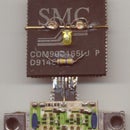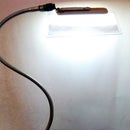Introduction: Valentine Heart
Two layered perspex heart with a light source inside it, to signify your burning love.
Step 1: The Pattern
First, you need a pattern for the heart. Draw half a heart on the left half of a sheet of paper, then darken it with a soft pencil.
Fold and rub along the line so that the carbon from the pencil lead transfers to the other side. This gives you a symmetrical heart.
Darken the faint outline, too, so that it is easily visible. Make any corrections as needed.
Now you have the paper pattern for the heart.
Fold and rub along the line so that the carbon from the pencil lead transfers to the other side. This gives you a symmetrical heart.
Darken the faint outline, too, so that it is easily visible. Make any corrections as needed.
Now you have the paper pattern for the heart.
Step 2: The Plastic
Now stick this paper pattern to your chosen plastic material. I used transparent perspex 4mm thick. It comes covered on both sides with brown paper.
Make rough cuts to approximately match the lines of your pattern, then remove material closer (or on the line) on a second pass. If you have a jigsaw you might be able to do it in one pass, but I was using a standard hack saw.
Then use a rough file or rasp to remove more material and smoothen the edges. Then use this as a pattern to make a copy on the second sheet of plastic: I used a sheet of opaque red perspex 3mm thick.
So there should be two sheets of plastic, each cut in the shape of a heart.
Make rough cuts to approximately match the lines of your pattern, then remove material closer (or on the line) on a second pass. If you have a jigsaw you might be able to do it in one pass, but I was using a standard hack saw.
Then use a rough file or rasp to remove more material and smoothen the edges. Then use this as a pattern to make a copy on the second sheet of plastic: I used a sheet of opaque red perspex 3mm thick.
So there should be two sheets of plastic, each cut in the shape of a heart.
Step 3: The Circuit:
The circuit is simple, with two cells in series feeding an LED via an optional series resistor.
With no resistor, the LED is brightest but the life is short. I selected a 220 ohm resistor as a compromise between reasonable life of the small battery and visible brightness.
Holes are drilled on the transparent sheet of perspex to accommodate the two cells and LED. The resistor is accommodated in a channel cut between the holes.
The components are soldered and pressed into the plastic so that the two sheets may be aligned and stuck to each other.
Remove the paper from the two surfaces of plastic, clean, and join them using superglue or chloroform. Clamp together for about an hour or so.
Then extract it from the clamps, remove the rest of the protective paper, insert the two cells as shown and hold them in place with some conducting springy stuff and a screw. The LED will light, and the edges of the transparent sheet will shine as well.
Present it to your chosen Valentine.
With no resistor, the LED is brightest but the life is short. I selected a 220 ohm resistor as a compromise between reasonable life of the small battery and visible brightness.
Holes are drilled on the transparent sheet of perspex to accommodate the two cells and LED. The resistor is accommodated in a channel cut between the holes.
The components are soldered and pressed into the plastic so that the two sheets may be aligned and stuck to each other.
Remove the paper from the two surfaces of plastic, clean, and join them using superglue or chloroform. Clamp together for about an hour or so.
Then extract it from the clamps, remove the rest of the protective paper, insert the two cells as shown and hold them in place with some conducting springy stuff and a screw. The LED will light, and the edges of the transparent sheet will shine as well.
Present it to your chosen Valentine.




